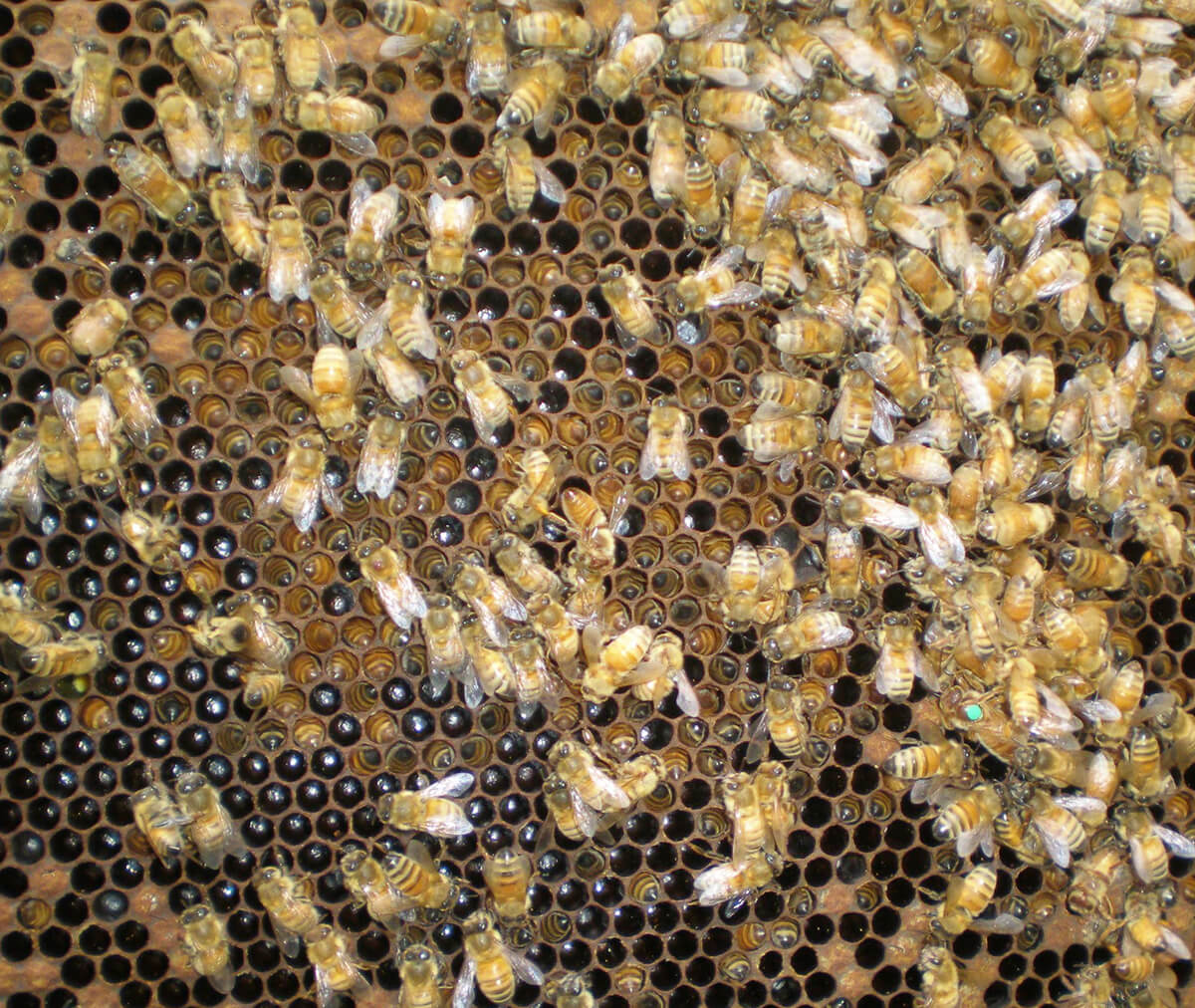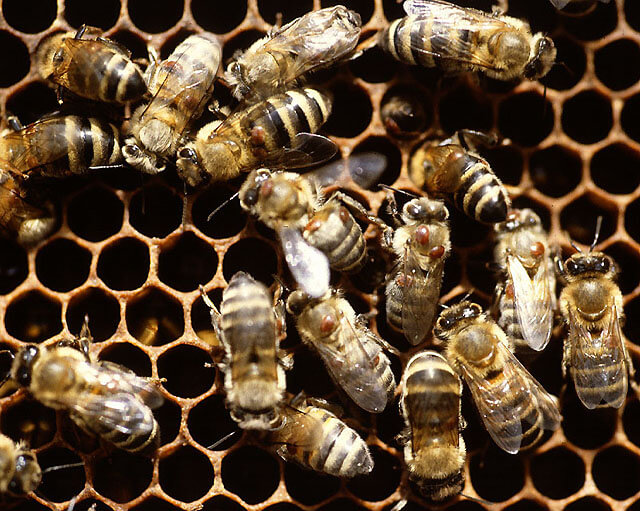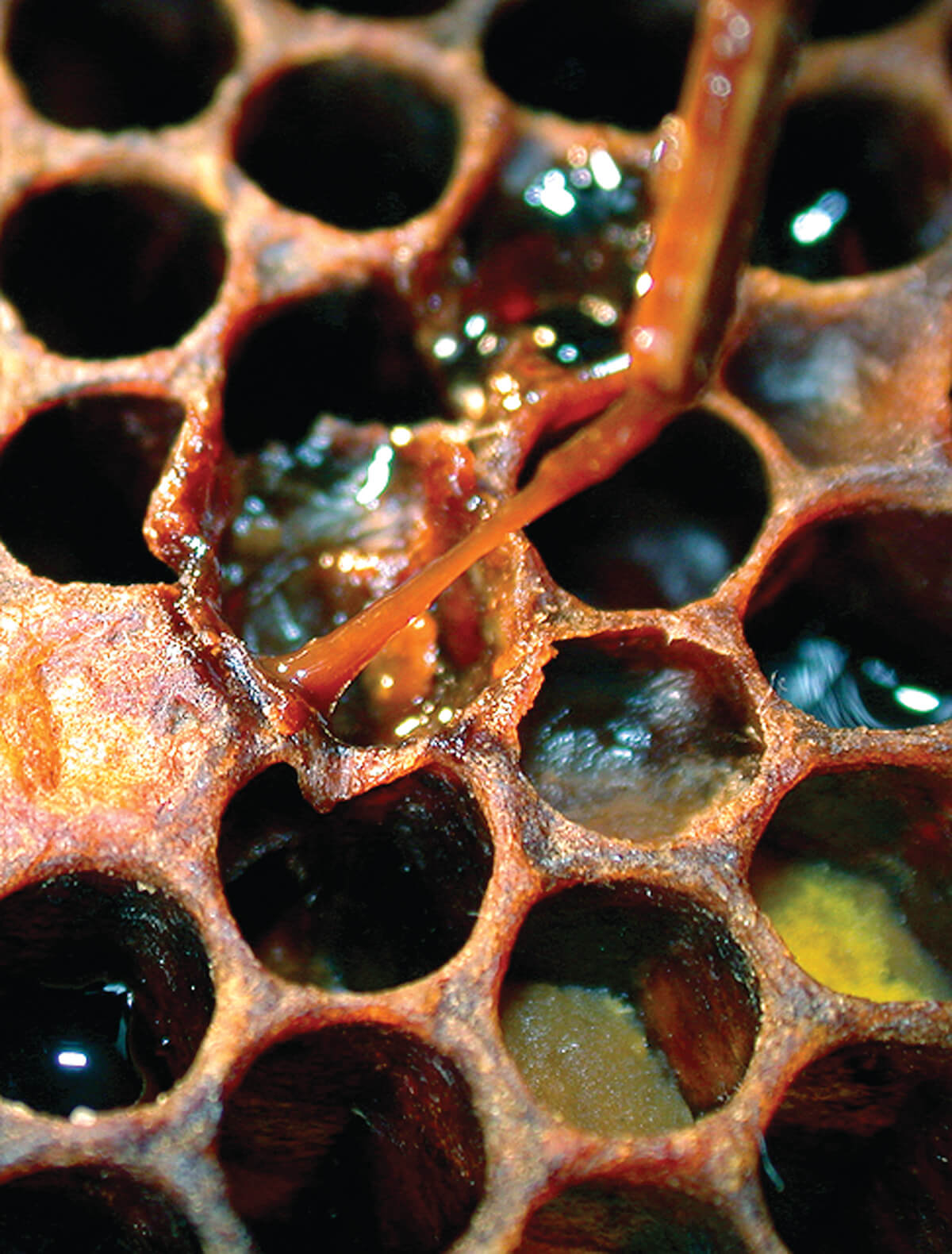If any of your colonies are still not thriving a month after swarm season ends in late spring/early summer, we need to figure out the problem and fast. What could it be? A disease? Varroa? Hunger? Why would one colony act differently than the others? It's so helpful to be able to compare different colonies, which is the main reason we encourage new beekeepers to either start with two hives or else to visit other beekeepers often. Not recognizing a hive that is lagging behind can lead to colony death, and beekeeper confusion and frustration.
When trying to analyze what might be wrong with a problem hive, consider the brood, the food, the workers, the queen, and the availability of comb.
An overview of a healthy colony's population growth and shrinkage over time
The typical annual pattern for a bee colony in good health is for the population to rise quickly from the end of winter to its largest size later in the warm season. This means both huge numbers of adult bees and a large brood nest. During the colony's weeks at its maximum population, swarming is much more likely to occur. Their instinct between the end of winter and the summer solstice is to make more colonies, so they build up fast, planning to swarm! (Or at least they increase their population drastically and then hopefully don't swarm due to your good beekeeping practices!)
After the main swarm season is over, population and brood nest size stay steady for a few weeks, then brood nest size begins to slowly shrink over the next few months. In late summer, as brood finishes developing and bees emerge, it's more likely that nectar will be deposited in the empty cells than the queen will lay eggs in them. The brood nest naturally fills up with nectar, then eventually honey at the end of the season. The hive's population may seem huge in early fall, but like the brood nest, it also is shrinking slowly because fewer bees are being raised. Fewer adult bees are around to replace the ones that reach the end of their lifespans.
In temperate climates, the normal pattern is to start with a big spring population buildup, swarming season, and a period of focused comb building. Later in the season, the colony eases off of these “growth” activities and quietly slides into a "pack in lots of groceries" phase before winter.
Start worrying that your colony is falling behind in the spring
Bees don't build much comb at all later in the summer. They're already planning for winter just a few weeks after the summer solstice, and turning nectar into wax means there will be less honey available as winter food. Feeding 1:1 syrup in later summer or early fall will get some comb drawn out, but not nearly as much as back in spring!
The first six weeks after the end of winter is the time for babying struggling colonies because, with some extra attention, they can still thrive later in the year. Then the colonies all need to be growing. By mid-summer, we don't want to have any colonies lagging behind, or colonies that need babying.
A common problem for honey bee colony growth: High varroa mite levels
A varroa treatment may resolve a lot of problems if the colony has high mite levels. However, the problem won't be obvious if you're not diligent about actually monitoring your mite population. Of course, varroa mite levels in all colonies should be kept low throughout the year. Mites are present in essentially every colony and are also quite likely to move from one to another through bees drifting or robbing from each other.
Unlike American Foulbrood, mites are treatable and don't remain in your equipment once the bees die. However, being so common, it is a major cause of bee decline and death. The dwindling adult population in fall and winter often causes a colony to freeze in cold areas because the cluster just doesn't have the mass to stay warm. Having a large enough winter population relates mainly to warmth, supremely important in areas where bees cluster through deep freezes. In cold regions, bees slowly eat through stored carbohydrates (honey, syrup, or sugar), move very little, and stay warm by vibrating their wing muscles. No matter how much honey they have, a bee cluster that is only a few inches in diameter will not be able to generate and hold enough heat to keep the cluster alive.
A common problem for honey bee colony growth: Hunger
Another problem often missed by beginners is simple hunger. If bad weather keeps foragers from collecting food, a new colony (or one that came out of winter with very little stored food) can linger on the edge of starvation while never quite dying. The queen will stop laying eggs and the workers may eat the brood. If you only think about brood and eggs when you inspect, you may blame the queen for this problem.
But by noticing the bone-dry empty combs, you should realize a donation of honey/pollen frames from another healthy hive may set them right. And if you don't have a food-filled hive nearby, feeding syrup and offering the colony part of a pollen patty should achieve the same result. Bees need pollen for protein and honey/nectar/syrup for carbohydrates. If your colony is missing anything, supplement them for a while and see if they can recover their strength and start foraging for themselves again.
Less common problem for honey bee colony growth: American Foulbrood
Aside from these examples, there are some nasty diseases that will prevent a colony from thriving. American Foulbrood is the nastiest, being very communicable, but also pretty rare. That means not many beekeepers see it, so they don't recognize it if it does appear. It remains in the brood comb for decades after a colony gets it, and a new nuc, package, or swarm hived in that equipment can get sick and succumb. It's not uncommon to find AFB in a beekeeper's hives if we're called in to inspect them because they “just never did well.”
You should be suspicious of possible brood disease whenever the brood looks abnormal. Open brood should be white and wet. Capped brood should be dry and not sunken. Multiple brood caps with holes in them are a bad sign, though the occasional centered hole on a cap may just mean that the workers haven't finished closing the cell yet. AFB cappings are sunken, damp, and usually have small holes. Since some dead pupae are uncapped, you may see the dark, dry, shrunken-down, dead pupa at the cell's lowest side.
If you are ever concerned about odd-looking brood, take close-up photos and then contact us, your state bee inspector, your local university extension office, or all three! Colonies with AFB will almost always be euthanized and then destroyed - hive and all - to prevent the disease from spreading to other colonies. The only upside to diagnosing AFB is that you'll know why your hive was struggling. Next year you'll get a fresh start with new equipment and new bees. You will also be able to recognize AFB in the future and can help other beekeepers detect it early.
A story from Betterbee's Head Beekeeper, Anne Frey: I followed the progress of one colony through summer: helping it, inspecting it, and treating it for mites. No luck. The population just never got to the level it should have. It was always queen right, and I saw the marked queen was the same one all through spring. Then one day I really stared at her as she wandered around a brood frame. She looked carefully in a cell, good. She pulled her head out and put her abdomen in… Wait… No, she didn't. She tried to, but she couldn't seem to curl her abdomen around and get it into the cell.
I watched and watched, and she only succeeded in laying an egg very rarely. I immediately crunched her with my hive tool, and put in a replacement queen later that day. The hive's population rose, and since it was still mid-summer they had enough time to really bounce back and prepare for winter. Even though I had seen a low number of eggs, and a scattered brood pattern, I'm sorry to say at first I just let it go, because everything else was fine. I did make a note on the hive's record, and knew it wasn't improving as I checked on them every 2-3 weeks or so. But when I REALLY looked again, I solved the problem.
As always, we are here to help you solve any mysteries with your colonies. Give us a toll-free call at 800-632-3379 or shoot us an inquiry to support@betterbee.com and we'll be happy to help!



